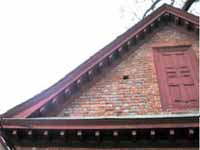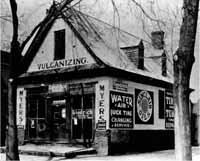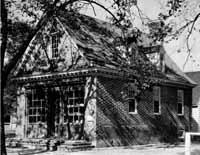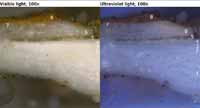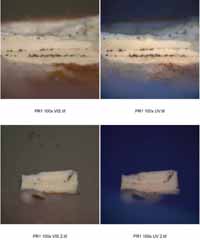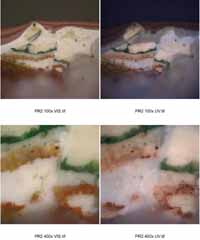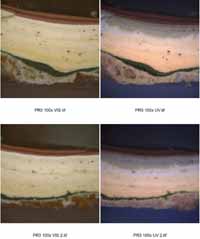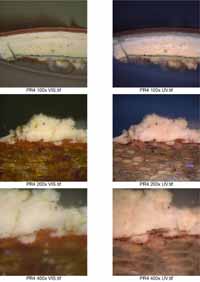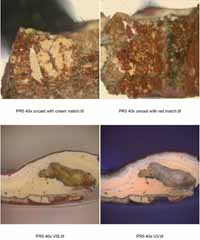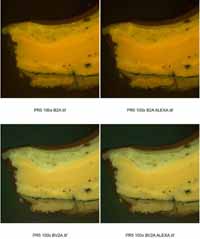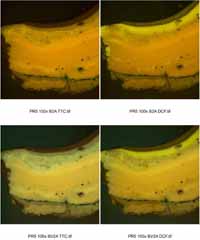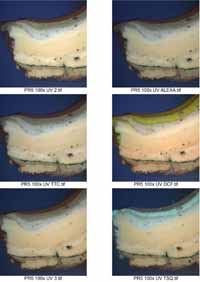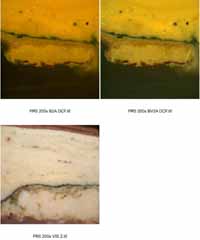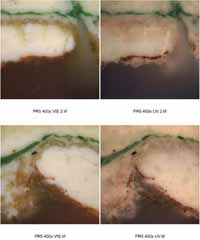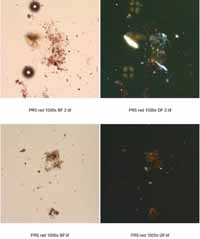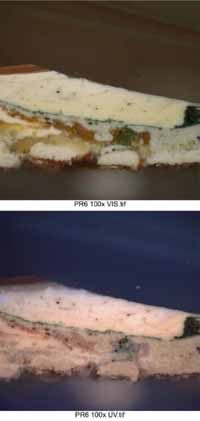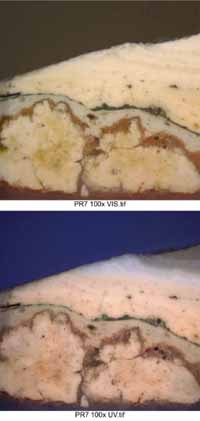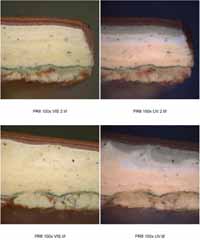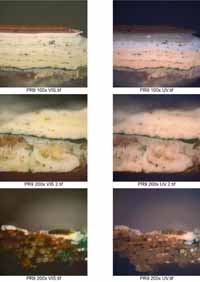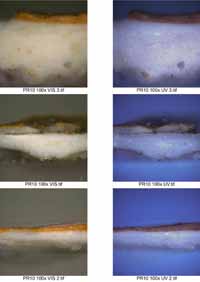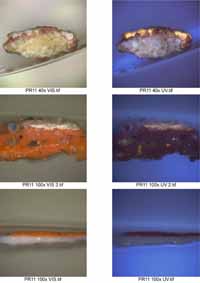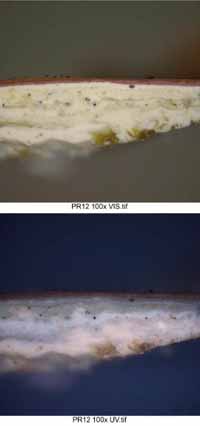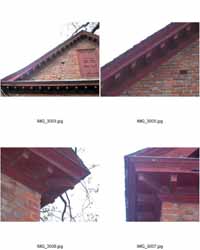Cross-Section Microscopy Analysis of Exterior Paints: Prentis Store (Block 18-1, Building 5), Williamsburg, Virginia
Colonial Williamsburg Foundation Library
Research Report Series - 1735
Colonial Williamsburg Foundation
Library
Williamsburg, Virginia
2012
Cross-Section Microscopy Analysis of Exterior Paints
Prentis Store
(Block 18-1, Building 5)
Williamsburg, Virginia
Table of Contents
| Purpose | 1 |
| Historical Background | 1 |
| Previous Research | 1 |
| Sampling Procedures | 3 |
| Sampling Locations | 3 |
| Results of Cross-Section Analysis | 4 |
| Cornice | 4 |
| Mortar | 10 |
| Results of Binding Media Analysis with Fluorochrome Stains | 11 |
| Results of Pigment Identification with Polarized Light Microscopy | 14 |
| Results of Color Measurement | 16 |
| Conclusion | 19 |
| Appendix | |
| Sampling Memorandum | 20 |
| Cross-Section Preparation Procedures | 22 |
| Binding Media Analysis Procedures | 22 |
| Pigment Identification Procedures | 22 |
| Color Measurement Procedures | 23 |
| Color Measurement Data | 24 |
| Contact Sheets of Cross-Section Photomicrographs | 25 |
Cross-Section Microscopy Analysis of Exterior Paints
| Structure: | Prentis Store, Colonial Williamsburg Foundation |
|---|---|
| Requested by: | Edward A. Chappell, Director, Architectural Research Department |
| Conservator: | Natasha K. Loeblich, Architectural Paint Analyst, Architectural Research Dept. |
| Consultant: | Susan L. Buck, Ph.D., Conservator and Paint Analyst |
| Date: | December 2007 |
Purpose
The goal of this project is to use cross-section microscopy to identify the early finishes, if they are present, in exterior paint samples from the c. 1736-38 Prentis Store. Of all the exterior trim, only the raking cornice on the front, south elevation seems to be original. Luckily, this element appears to have retained its full finish history. For this research, samples were taken from the main and raking cornice on the front, south elevation, and from the brickwork.
Historical Background
There are a few photographs of the Prentis Store before its 1928-31 restoration, which show that all the exterior brickwork was painted over and that changes were made to the front entrance (see page 2). According to the restoration report: "In spite of its disfigurement by painting and advertising matter the shell of the building was, surprisingly enough, more or less intact. The pediment with its modillion cornice still existed and furnished the model for the restoration of this feature… The paint with which a large part of the brickwork had been covered was removed in the course of restoring the building. Upon its removal it was discovered that much of the old patterned brickwork, with its glazed and semi-glazed headers, remained."1 The restoration report also states: "The old [main] cornice found in place at the time of restoration of the building furnished the basis for the design of the present cornice. This cornice, when examined at the site, appeared to be wholly new, although notes on working drawings made prior to the restoration of the building state that the existing cornice is to be repaired." This report notes that: "The colors used on the Exterior are as follows:
| Show Window & Exterior Door | #1 dark gray |
| Window Frames & Cornice | #696, white |
| Rear Porch Floor | #25, tope" |
Previous Research
Frank S. Welsh undertook an examination of the exterior finishes of the Prentis Store in 1989. His analysis suggested that the east cornice was originally painted with a "Moderate Reddish Brown" primer and finish coat. Above this he found a layer of grime. The next two finishes were apparently white paints and he dated these to the eighteenth century as well. Welsh identified the reddish brown primer and finish coat has having a color closest to Munsell swatch 10R 3/5 and the closest match to the white was 5Y 9/0.5.2
Sampling Procedures
The twelve exterior samples examined in this report were taken by Edward Chappell and Natasha Loeblich on October 5, 2007 with a scalpel. Nine of the samples were taken from the raking cornice which on-site appeared to be the only original element with a significant accumulation of paint. An additional sample was taken from the corner modillion block on the southeast corner where the raking and main cornice intersect, though this element was probably replaced along with the rest of the main cornice. Two additional samples were taken from coatings on the brickwork for analysis. All the samples were collected on-site in labeled bags and each was given a unique number corresponding to its recorded sample location. The exact sample locations are provided in the following table.
Sampling Locations
| Sample | Location |
|---|---|
| PR1 | Seventh modillion, counting up from lower west, west side of modillion just below cymatium |
| PR2 | Soffit between fifth and sixth modillions, from lower west, at the back |
| PR3 | Seventh modillion, west side, 1" from rear |
| PR4 | Rear fascia between fifth and sixth modillions, from lower west, just below cymatium |
| PR5 | Rear fascia, base of cymatium, immediately west of fifth modillion from lower east |
| PR6 | Fifth modillion, from lower east, cymatium at rear |
| PR7 | Bottom of cymatium, immediately east of sixth modillion, from lower east |
| PR8 | Cymatium at rear, on west side of fourth modillion, from lower east |
| PR9 | Rear fascia, at cymatium, between sixth and seventh modillions, from lower east |
| PR10 | Paint on brickwork in pediment just below raking cornice, under eighth modillion from lower east, 1½" below bed molding |
| PR11 | Paint on brick of east wall, ½" below bed molding, 3' 4" north of southwest corner, below fifth modillion, counting from southeast corner |
| PR12 | Southeast corner modillion, east side, 2" out from back, immediately below cymatium |
Results of Cross-section Analysis
During on-site examination of the building with Chappell, it appeared that the raking cornice might be the only original woodwork left since only this element appeared to have a significant accumulation of finishes. The most complete samples from the raking cornice do have an extended stratigraphy in cross-section. Trapped in the wood cells of the substrate are pockets of a dull bluish fluorescent plant resin that are probably the remains of a resin sealant added to the wood before painting. As found by Welsh, the first generation of paint is a deep red with some grime above it. Welsh stated that the red was composed of a primer and finish coat of the same color, but no evidence of more than one layer was detected in any of the cross-sections. The generation one red paint is worn and disrupted as if it was left to weather for a significant period of time before the next paint was added. Generation two is a thick cream-colored paint that flowed into cracks in the red layer indicating that the red was a presentation surface for a long enough time to weather and crack before the next generation was applied.
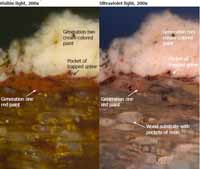 Sample PR4, front raking cornice, rear fascia between fifth and sixth modillions, from lower west, just below cymatium
Sample PR4, front raking cornice, rear fascia between fifth and sixth modillions, from lower west, just below cymatium
In sample PR5 generation three is another cream-colored paint. This layer aged and became cracked before the next paint was applied. In most cross-sections only islands of the first three generations were found, indicating that before generation four was applied the earliest finishes on this building were allowed to wear almost completely away.
Generation four is a resinous red paint that aged and cracked before the next paint was applied. This paint is seen more clearly in the cross-section photomicrographs on the next page. Generation five is a finely-ground, light gray paint and generation six is a thin, dark green paint with very little autofluorescence. Above this are eight generations of cream-colored paint, most of which are separated by some grime accumulation.
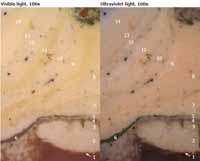 Sample PR5, front raking cornice, rear fascia, base of cymatium, immediately west of fifth modillion from lower east
Sample PR5, front raking cornice, rear fascia, base of cymatium, immediately west of fifth modillion from lower east
The cross-section image below from sample PR7 shows the red and gray paints in generations four and five more clearly. The earlier layers cracked in places allowing the later layers to flow in.
The early paints found in generations one through three are very cracked and weathered and were missing from some samples. In his report Welsh stated that the first generation of paint was composed of a red primer and finish coat. It may be that his samples were missing fragments of the cream-colored paints in generations two and three and it appeared that the red paint in generation four was a finish coat for the red paint in generation one. Or, he may not have been observing the samples at high enough magnification to clearly assess the nature of the first deep red coating.
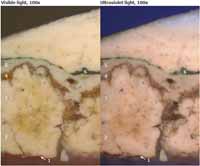 Sample PR7, front raking cornice, bottom of cymatium, immediately east of sixth modillion, from lower east
Sample PR7, front raking cornice, bottom of cymatium, immediately east of sixth modillion, from lower east
There are four generations of white paints at the top of the cross-section from sample PR3. Generation fifteen is the first layer that seems to contain the pigment zinc white (identified by its characteristic spots of yellow-green fluorescence). The presence of zinc in this layer was confirmed with fluorochrome staining (see page 13). The use of zinc white dates the layer to after 1845 when the pigment became commercially available for use in oil paint.1 Generation sixteen, which has a bluish fluorescence, and generation seventeen, which has a green and blue fluorescence, both also contain zinc white. Generation eighteen is a modern white paint applied in two coats. Generations nineteen and twenty are modern, dark red paints applied in two coats. These must both postdate Welsh's 1989 report in which he found that the first-generation paint was red.
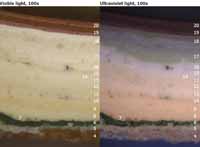 Sample PR3, front raking cornice, seventh modillion, west side, 1" from rear
Sample PR3, front raking cornice, seventh modillion, west side, 1" from rear
The two corner modillion blocks in the join between the raking and main cornice seemed to show evidence of wear when they were examined on-site, which suggested that they might predate the replaced main cornice. However, the cross-sections from the southeast corner modillion indicate that the finish history begins with the cream-colored paint found in generation thirteen on the raking cornice. There is no evidence of earlier finishes trapped in the wood cells, so the corner modillions are probably contemporary with the rest of the main cornice. The finish history of the cornice and on-site examination suggests that most of the trim was probably replaced in the 1928-31 restoration, as suggested in the restoration report.
 Sample PR12, front cornice, southeast corner modillion, east side, 2" out from back, immediately below cymatium
Sample PR12, front cornice, southeast corner modillion, east side, 2" out from back, immediately below cymatium
Two samples were taken from the brickwork where there was obvious evidence of coatings. Several of the cross-sections from the sample on the south elevation show an accumulation of at least four unpigmented limewashes, identified by their translucency and fluorescence. Generation five is a gray pigmented limewash with some red and black pigments. Generations six and seven are more unpigmented limewashes and generation eight is a red-pigmented limewash. The limewashes can not be accurately dated because they appear to have compositions and pigments that have been in use for hundreds of years. Generation nine is white paint that is missing from this cross-section from sample PR10. Generation ten is a modern red paint with no fluorescence that probably relates to the paints applied to the trim in generation nineteen and twenty.
 Sample PR10, paint on brickwork in pediment just below front raking cornice, under eighth modillion from lower east, 1½" below bed molding
Sample PR10, paint on brickwork in pediment just below front raking cornice, under eighth modillion from lower east, 1½" below bed molding
The sample from the brickwork on the east elevation is more fragmentary but has evidence of two unpigmented limewashes and a red limewash that appears to relate to generation eight on the front elevation. This sample also has evidence of a modern white paint in generation nine that may have survived from the period when the Prentis store was a service station, before the 1928-31 restoration.
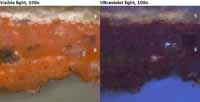 Sample PR11, paint on brick of east wall, ½" below bed molding, 3' 4" north of southwest corner, below fifth modillion, counting from southeast corner
Sample PR11, paint on brick of east wall, ½" below bed molding, 3' 4" north of southwest corner, below fifth modillion, counting from southeast corner
Results of Binding Media Analysis with Fluorochrome Stains
A cross-section from sample PR5 from the raking cornice was chosen for binding media analysis since it has a complete stratigraphy. The cross-section was treated with biological fluorochrome stains that mark out proteins, carbohydrates, oils, and zinc (Zn2+) in the layers. No positive reactions were observed for proteins or carbohydrates. Several layers did react positively for oils, however, when the fluorochrome stain DCF was applied. In the images below, all the early layers show a faint pink reaction color for saturated lipids, which is appropriate for aged oil paints. The upper layers have a yellow positive reaction color that indicates the presence of unsaturated lipids, which is consistent with less aged oil paints.
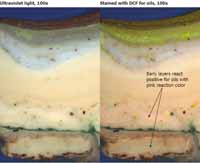 Sample PR5, front raking cornice, rear fascia, base of cymatium, immediately west of fifth modillion from lower east
Sample PR5, front raking cornice, rear fascia, base of cymatium, immediately west of fifth modillion from lower east
The color of the first-generation red paint is probably masking a pink positive reaction color, but the cream-colored paint directly above the red paint stained pink. This could be attributed to the cream-colored paint having absorbed oil from the oil binder of the red paint below it. This could indirectly suggest that the red paint is oil bound as well.
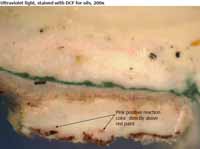 Sample PR5, front raking cornice, rear fascia, base of cymatium, immediately west of fifth modillion from lower east
Sample PR5, front raking cornice, rear fascia, base of cymatium, immediately west of fifth modillion from lower east
There were positive reactions for zinc (Zn2+) beginning in the white paint of generation fifteen, as shown by a bright blue reaction color. Since a feasible commercial method for delivering zinc white pigment in oil paint was not developed until 1845, generation fifteen must postdate this.
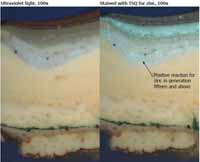 Sample PR5, front raking cornice, rear fascia, base of cymatium, immediately west of fifth modillion from lower east
Sample PR5, front raking cornice, rear fascia, base of cymatium, immediately west of fifth modillion from lower east
Results of Pigment Identification with Polarized Light Microscopy
Dispersed pigments from the first-generation red paint in sample PR5 were examined with polarized light microscopy to determine the pigment composition. The red paint was found to contain an iron oxide red (possibly red ochre or Spanish brown), lamp black, and some lead white. Because of the thinness of this layer it is not possible to be sure that the lead white pigment is not a contaminant from the adjacent cream-colored paint layers. However, in some of the cross-sections there seem to be clumps of a white pigment in the red paint (see the cross-section photomicrographs for sample PR5 on page 12). All three of the pigments detected in the red paint are common and relatively inexpensive pigments that were readily available in the eighteenth century.
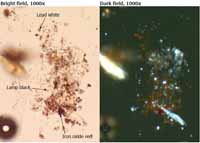 PR5 dispersed pigment particles from first-generation red paint
PR5 dispersed pigment particles from first-generation red paint
A dispersed pigment sample from the second-generation cream-colored paint was examined with polarized light microscopy as well. The paint was isolated from uncast portions of sample PR5. This paint was found to be colored only with lead white.
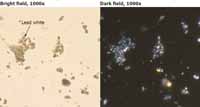 PR5 dispersed pigment particles from second-generation cream-colored paint
PR5 dispersed pigment particles from second-generation cream-colored paint
Results of Color Measurement
Color measurements were undertaken for this report from sample PR5 from the raking cornice, which had good evidence of the early paint generations. Four color measurements were taken from the first-generation red paint and five from the second-generation cream-colored paint. All the color measurements from each color were averaged to find the one measurement that was closest to the average.
The closest measurement to the average color value of the first-generation red paint had an L* value of 36.93, an a* value of +15.69, and a b* value of +14.03 in the CIE L*A*b* color system. In the Munsell system, the red paint was found to have a hue of 10.0R, a value of 3.8, and a chroma of 3.7. In his 1998 report, Welsh found a red primer and finish coat in the first generation that he gave a hue of 10R, a value of 3, and a chroma of 5.
Under magnification with a color-corrected light source, the best commercial paint match found to the first-generation red paint was Benjamin Moore 2104-30 "Harvest Brown" which has an L* value of 38.21, an a* value of +17.66, and a b* value of +13.36. This commercial paint color is different from the color of the first-generation red paint by a ΔE value of 2.44. Thus this commercial paint match could be used for reproducing the first-generation red paint on the raking cornice and, by extrapolation, the rest of the exterior trim.
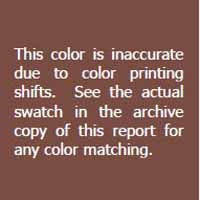 Benjamin Moore 2104-30, best commercial match to first-generation red paint
Benjamin Moore 2104-30, best commercial match to first-generation red paint
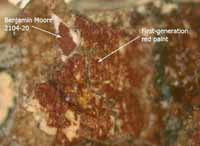 Upside-down uncast sample showing first-generation red paint and commercial color match
Upside-down uncast sample showing first-generation red paint and commercial color match
The current red paint on the trim was also measured and was found to have an L* value of 35.68, an a* value of +14.49, and a b* value of +14.76 in the CIE L*A*b* color system. In the Munsell system, the red paint was found to have a hue of 1.3YR, a value of 3.5, and a chroma of 3.7. This is different from the first-generation red paint by a ΔE value of 1.88 being slightly darker and slightly less red. Thus, the current red paint being applied to the trim is an acceptable match for the original paint.
The second-generation cream-colored paint was also measured. The closest actual measurement to the average color value of first-generation red paint was found to have an L* value of 72.55, an a* value of +0.13, and a b* value of +15.01 in the CIE L*A*b* color system. In the Munsell system, the cream-colored paint was found to have a hue of 2.6YR, a value of 7.2, and a chroma of 2.2. In his report Welsh also noted that the second-generation finish was a cream-colored paint. He found that this cream-colored paint had a hue of 5Y, a value of 9, and a chroma of 0.5 in the Munsell system.
Under magnification with a color-corrected light source, the best commercial paint match found to the second-generation cream-colored paint was Pittsburgh Paints 414-4 "Dusty Trail", which has an L* value of 75.79, an a* value of +0.17, and a b* value of +14.70. This commercial paint color is different from the color of the first-generation red paint by a low ΔE value of 2.74. Thus this commercial paint match could be used for reproducing the second-generation cream-colored paint on the raking cornice and, by extrapolation, the rest of the exterior trim.
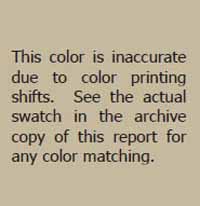 This color is inaccurate due to color printing shifts. See the actual swatch in the archive copy of this report for any color matching.
This color is inaccurate due to color printing shifts. See the actual swatch in the archive copy of this report for any color matching.
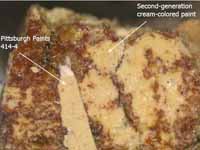 Upside-down uncast sample showing second-generation cream-colored paint and commercial color match
Upside-down uncast sample showing second-generation cream-colored paint and commercial color match
The commercial color match on the previous page represents an aged and darkened state of the second-generation cream-colored paint since it is known that oil binders often darken with age. During pigment identification this paint was found to be colored only with lead white pigment so its current yellowed appearance is due to darkening of the oil binder with age and not intentional pigmentation. Thus, if the Prentis store is was to be repainted with a paint to represent its second-generation finish, it might be more accurate to repaint the trim with a color representative of fresh lead white in linseed oil. A fresh paint composed of lead white in linseed oil would certainly originally have been much lighter, though not as bright as a modern "cool" white. A batch of lead white in linseed oil paint prepared by Susan Buck in 2004 and applied to a shellacked pine board was measured at that time to have a color value of L* 91.07, a* -1.26, b* +11.29. A good commercial paint match to this is Martin Senour CW 707 "Bracken Cream Medium White" from the Williamsburg Color Collection. This paint has a value of L* 90.40, a* -1.60, b* +10.60, which is different from the fresh lead white in linseed oil paint by a low ΔE value of only 1.02. Hence, this commercial paint match could be used for reproducing a fresh lead white in linseed oil paint, which is what the evidence suggests was the second generation of paint originally applied to the cornice and probably all the trim. Furthermore, the second-generation cream-colored paint is the layer most likely to date to the 1770s, the period of interpretation in the historic area.
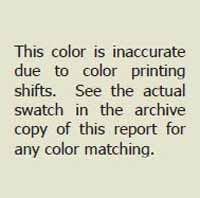 Martin Senour CW707, best commercial match to fresh lead white in linseed oil
Martin Senour CW707, best commercial match to fresh lead white in linseed oil
Conclusion
Analysis of the samples collected from the raking cornice of the Prentis Store indicates that there is still evidence of early paint on this element, though the remains of the first three generations are fragmentary. No other trim appeared early during on-site examination, except the corner modillions at the join of the raking and the main cornice. However, when these were sampled, their finish history indicated that they were installed around the time the thirteenth generation of paint was applied. This suggests that the corner modillions were replaced along with most of the other trim during the 1928-31 restoration of the building.
On the raking cornice, the first generation of paint was red. There are pockets of a bluish fluorescent resin in the wood cells that suggest the wood might have been treated with a plant resin sealant before painting. Using polarized light microscopy, the red paint was found to contain an iron oxide red, probably either red ochre or Spanish brown, and lamp black pigment. Lead white was also detected, but because of the difficulty in isolating the remains of the red paint from the later layers, it is not possible to be sure that the lead white is not a contaminant. Fluorochrome stains indirectly suggest that the red paint is oil bound. In cross-section it is evident that the red paint is thin and weathered, so even though there is not a significant grime accumulation on the surface of this layer, it must have been a presentation surface that was exposed to wear.
The second and third generations of finish on the raking cornice were cream-colored paints. Using polarized light microscopy, these paints were found to be colored only with lead white. Fluorochrome stains indicate that the cream-colored paints have oil binders. The second-generation cream-colored paint flowed into cracks in the red paint below it indicating that the two were not applied at the same time.
Generation four on the raking cornice is a resinous red paint, generation five is a light gray paint, and generation six is a dark green paint. Above this are twelve more generations of cream-colored or white paints. Generation fifteen was the first layer found to contain zinc when fluorochrome stains were applied. The presence of zinc white pigment in this layer dates it to after 1845. The last two generations are dark red paints applied in two coats. These layers must post date Welsh's 1989 report in which he found a red paint in generation one.
Color measurements were taken of the first-generation red paint and the second-generation cream-colored paint and commercial paint matches were given for both paints. The current red paint being applied to the house is not a bad match, but is slightly darker and slightly less red than the original paint. The commercial paint match provided in this report for the second-generation cream-colored paint is quite yellow because the paint was not light bleached. Since the cream-colored paint was found to contain only lead white pigment in an oil binder, its current color must be due to degradation and darkening of the oil binder rather than pigmentation. Therefore it might be more accurate to use a paint matched to a fresh batch of lead white in linseed oil and a commercial paint match for a paint of this formulation was also provided. Since the historic area is interpreted to the 1770s, the best representation of the building in this period would probably be a paint matched to lead white in a fresh oil binder which would represent the original appearance of the second-generation cream-colored paint.
The brickwork on the Prentis Store was found to have a surprising number of coatings. There was evidence of four unpigmented limewashes, a gray pigmented limewash, two more unpigmented limewashes, and a red limewash. Unfortunately, these limewashes seem to have traditional compositions and common pigments that make it impossible to date them. In addition, a white paint was found that might be a remnant from when the building was a painted service station, as documented in photographs taken before the restoration. A red paint was also found that probably relates to the current modern red paint on the trim.
Footnotes
Appendix
Sampling Memorandum
From: Chappell, Edward
To: Loeblich, Natasha
Subject: Exterior Paint Samples - Prentis Store, Block 18-1, Building 5
These are the locations from which we took paint samples from the pediment of Prentis Store this morning. Most of the original cornice appeared to survive before the building was restored in 1928-31. Now only the raking parts of the pediment seem original. They are substantially weathered and appear to retain early paint. With the naked eye, we see red-brown, over white, which seems to be over remnants of green and red-brown.
The two corner modillions in the main cornice are also heavily weathered, and that at the southeast corner appears to have part of a different cymatium. However, when taking a sample from the latter modillion, the wood appeared different, and I saw fewer paint layers, again with the naked eye.
The cornice appears to have had dark paint when photos were taken in the 1920s. This might be the green we saw in crevices on the modillions. It was painted white until Frank Welsh identified red-brown as its earliest finish paint in 1989. It was then painted the present red-brown, based on Frank's 10 R 3/5 reading and Munsell color chips.[1]
- A.Seventh modillion, counting up from lower west, west side of modillion just below cymatium.
- B.Soffit between fifth and sixth modillions, from lower west, at the back.
- C.Seventh modillion, west side, 1" from rear.
- D.Rear fascia between fifth and sixth modillions, from lower west, just below cymatium.
- E.Rear fascia, base of cymatium, immediately west of fifth modillion from lower east.
- F.Fifth modillion, from lower east, cymatium at rear.
- G.Bottom of cymatium, immediately east of sixth modillion, from lower east.
- H.Cymatium at rear, on west side of fourth modillion, from lower east.
- I.Rear fascia, at cymatium, between sixth and seventh modillions, from lower east. (Paint looks shiny.)
- J.Paint on brickwork in pediment just below raking cornice, under eighth modillion from lower east, 1½" below bed molding. (Both red and white paint visible, more than on fully exposed brickwork.)
- K.Paint on brick of east wall, ½" below bed molding, 3' 4" north of southwest corner, below fifth modillion, counting from southeast corner.
- L.Southeast corner modillion, east side, 2" out from back, immediately below cymatium. Does not appear to have much paint, possibly replaced 1928-31.
Two factors are worth mentioning. First, the building is relatively early, c.1736-38 according to Jack Heikkenen's dendrochronology, possibly first painted in 1740, when the latter date was scratched in attic wall plaster. Second, this was a fancy building —— expensively 21 finished when compared to other surviving.
E.A.C.
Cross-section Preparation Procedures
The samples were initially examined with a stereomicroscope under low power magnification (5 to 50 times magnification) and divided as needed. When possible, a portion of each sample was kept in reserve for future analysis and a portion cast in a labeled cube of a commercial two-part polyester resin manufactured by Excel Technologies, INC. (Enfield, CT). The resin was cured under an incandescent lamp for several hours. The resin cubes were then ground on a motorized grinding wheel with 400 grit sandpaper to reveal the cross-sections. Final finishing was achieved using a Buehler Metaserv 2000 grinder polisher equipped with abrasive cloths from Micro Mesh, INC. with grits of 1500 to 12,000.
Cross-section microscopy analysis was performed using a Nikon Eclipse 80i microscope equipped with an EXFO X-Cite 120 Fluorescence Illumination System fiberoptic halogen light source. The cross-sections were examined at magnifications of 40x, 100x, 200x, and 400x using reflected visible light and a UV-2A fluorescence filter cube with a 330-380nm excitation. The cross-sections were photographed digitally using an integral Spot Flex digital camera with Spot Advanced (v. 4.6) software. The light levels of the images were adjusted in Adobe Photoshop CS2. The color on the digital images is somewhat indicative of the actual color of the paints, but cannot be used for color matching as the printing process can cause color shifts.
Under ultraviolet light many materials have characteristic autofluorescence colors that can suggest their composition. For example, most natural resin varnishes have a bright whitish autofluorescence while oil varnishes tend to be darker in ultraviolet light. Visible light microscopy can also yield valuable information. The presence of soiling layers or weathering can indicate that the finish layer existed as a presentation surface for a period of time. Since many interior finishes, such as faux graining, make use of a predictable sequence of layers, it is important to determine which layers were meant to be final presentation surfaces.
Binding Media Analysis Procedures
To better understand the composition of the paint binders, selected cross-sections were stained with biological fluorochrome stains to indicate the presence of carbohydrates, proteins, oils, and zinc in the paint binders. The stains used were ALEXA (0.1% w/v Alexafluor 488 in dimethylformamide brought to a pH of 9.0 with 0.5% borate) which marks proteins bright green, TTC (4% w/v triphenyl tetrazolium chloride in methanol) which marks carbohydrates dark red-brown, DCF (0.2% w/v 2,7 dichlorofluorescein in ethanol) which marks saturated lipids pink and unsaturated lipids yellow, and TSQ (0.2% w/v N-(6- methyl-8-quinolyl)-p-toluenesulfonamide in ethanol) which marks zinc (Zn2+) blue-white.
Pigment Identification Procedures
Samples with good accumulations of early paints identified through cross-section microscopy were scraped with a scalpel under magnification to reveal the target paint layer. A small amount of this layer was then scraped onto a glass microscope slide, dispersing the pigments. The dispersed pigments were permanently embedded under a cover slip in Cargille Meltmount (Cargille Labs., Cedar Grove, NJ). The Meltmount used has a refractive index of 1.662. The prepared slides were then examined under the microscope with transmitted visible light using a polarizing filter at a magnification of 1000x with an oil immersion objective. The morphological and optical properties of the pigment particles was observed and compared to reference pigment samples.
Color Measurement Procedures
Color measurements were made using uncast samples that were selected under magnification. An effort was made to find a clean, unweathered areas for measurement whenever possible. All color measurements were made using a Minolta Chromameter CR-241 with a measurement area of 0.3mm for uncast samples and a measurement area of 1.8mm for paint swatches. This microscope has an internal, 360° pulsed xenon arc lamp and can measure color with five color systems. The color systems used in this report are the CIE (Commission International de l'Eclairage) L*a*b* and the Munsell color system. Both systems use three values called tristimulus values to measure color that include hue (or color), the chroma (or saturation), and lightness to darkness. In the CIE L*a*b* color system L* represents lightness from 1 to 100 with 100 being the lightest, a* represents red to green with positive numbers being more red and negative numbers more green, and b* represents yellow to blue with positive numbers being more yellow and negative numbers more blue. This system was adjusted from the CIE Yxy system developed in 1931 to better represent the human eye's sensitivity to color. In the Munsell system, color measurements are given in the form of hue value/chroma with value representing lightness to darkness. Color measurement values are compared to each other using the ΔE formula which calculates the difference between two color measurements.1 The ΔE formula equals the square root of the sum of the differences in the L* value squared, the differences in the a* value squared, and the differences in the b* value squared. Generally, a ΔE value of less than two represents colors that are difficult for the human eye to differentiate.
Commercial color matches were found using a database of CIE L*a*b* values of paints from Benjamin Moore, Sherwin William, Martin Senour, and Pittsburgh Paints that calculates ΔE values. The matches with the lowest ΔE values were compared to the uncast sample under magnification with a color-corrected light source to choose a final match.
Color measurement Data
First-generation red paint
| Delta E from average | best match to average | ||||
|---|---|---|---|---|---|
| PR5 | 36.93 | 15.69 | 14.03 | 0.40 | |
| PR5 | 39.26 | 15.02 | 13.39 | 2.48 | |
| PR5 | 36.83 | 15.74 | 14.88 | 1.15 | |
| PR5 | 34.33 | 15.09 | 12.85 | 2.69 | |
| AVERAGE | 36.84 | 15.39 | 13.79 | ||
| Munsell | H=10.0R | V=3.8 | C=3.7 |
| Delta E from average | Delta E from best match to average | Delta E for color to best match | ||||
|---|---|---|---|---|---|---|
| Current Red | 35.68 | 14.49 | 14.76 | 1.76 | 1.88 | |
| Munsell H=1.3YR | V=3.5 | C=3.7 |
| BM 2104-20 | 36.19 | 16.72 | 14.70 | 1.74 | 1.43 | 1.23 |
| SW 2721 | 38.68 | 15.56 | 14.19 | 1.89 | 1.76 | 0.21 |
| SW 1336 | 38.29 | 14.52 | 15.03 | 2.10 | 2.05 | 1.54 |
| BM 2104-30 | 38.21 | 17.66 | 13.39 | 2.69 | 2.43 | 2.07 Harvest Brown |
| SW 2715 | 36.38 | 16.86 | 11.75 | 2.56 | 2.62 | 2.56 |
| SW 1315 | 34.91 | 13.69 | 12.95 | 2.70 | 3.04 | 2.27 |
| BM 2104-10 | 34.06 | 17.02 | 15.32 | 3.57 | 3.42 | 1.85 |
| SW 2837 | 36.66 | 12.96 | 11.68 | 3.22 | 3.61 | 3.60 |
Second-generation cream-colored paint
| Delta E from average | |||||
|---|---|---|---|---|---|
| PR5 | 73.06 | -0.05 | 14.72 | 1.10 | |
| PR5 | 71.35 | 0.79 | 16.10 | 1.34 | |
| PR5 | 73.35 | 1.25 | 16.66 | 1.66 | |
| PR5 | 72.10 | 0.85 | 14.53 | 0.99 | |
| PR5 | 72.55 | 0.13 | 15.01 | 0.61 | best match to average |
| AVERAGE | 72.48 | 0.59 | 15.40 | ||
| Munsell | H=2.6Y | V=7.2 | C=2.2 |
| Delta E from average | Delta E from best match to average | Delta E for color to best match | |||||
|---|---|---|---|---|---|---|---|
| BM HC 82 | 73.08 | -0.54 | 15.47 | 1.28 | 0.90 | 0.90 | |
| SW 6150 | 71.65 | -0.48 | 13.22 | 2.57 | 2.10 | 1.56 | |
| SW 2058 | 74.35 | -0.03 | 13.93 | 2.46 | 1.51 | 0.79 | |
| BM HC 95 | 70.78 | -0.68 | 14.01 | 2.54 | 2.47 | 0.95 | |
| SW 2065 | 74.44 | -0.28 | 13.79 | 2.68 | 1.68 | 0.96 | |
| SW DCR 003 | 74.95 | 0.58 | 15.76 | 2.49 | 2.25 | 1.22 | |
| SW 2072 | 70.81 | -0.02 | 12.97 | 3.02 | 2.85 | 1.75 | |
| SW 6157 | 72.91 | -1.34 | 17.46 | 2.85 | 3.03 | 3.03 | |
| PP 415-4 | 74.74 | 1.19 | 13.04 | 3.32 | 2.68 | 2.09 | |
| BM HC 79 | 70.00 | 0.26 | 16.92 | 2.93 | 3.78 | 2.22 | |
| PP 414-4 | 75.79 | 0.17 | 14.70 | 3.41 | 2.74 | 0.22 | Dusty Trail |
| SW 6143 | 71.42 | 0.36 | 18.83 | 3.59 | 4.44 | 4.13 |
